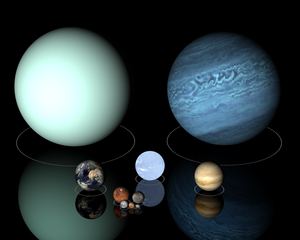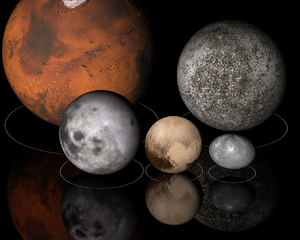Planet: Astronomical object orbitin a starn or stellar remnant that is massive enough tae be roondit bi its ain gravity
A planet (frae Auncient Greek ἀστὴρ πλανήτης (astēr planētēs), meanin 'wanderin starn') is an astronomical object orbitin a starn or stellar remnant that is massive enough tae be roondit bi its ain gravity, is nae massive enough tae cause thermonuclear fusion, an haes cleared its neighbourin region o planetesimals.
The term planet is auncient, wi ties tae history, science, meethology, an releegion. The planets wur oreeginally seen bi mony early culturs as divine, or as emissaries o deities. As scientific knawledge advanced, human perception o the planets chynged, incorporatin a nummer o disparate objects. In 2006, the Internaitional Astronomical Union (IAU) offeecially adoptit a resolution definin planets within the Solar Seestem. This defineetion haes been baith praised an criticized an remains disputit bi some scientists acause it excludes mony objects o planetary mass based on whaur or whit thay orbit. While aicht o the planetary bodies discovered afore 1950 remain "planets" unner the modren defineetion, some celestial bodies, such as Ceres, Pallas, Juno, Vesta (each an object in the Solar asteroid belt), an Pluto (the first-discovered trans-Neptunian object), that wur ance considered planets bi the scientific community are nae langer viewed as such.
The planets wur thoucht bi Ptolemy tae orbit the Yird in deferent an epicycle motions. Altho the idea that the planets orbitit the Sun haed been suggestit mony times, it wis nae till the 17t century that this view wis supportit bi evidence frae the first telescopic astronomical observations, performed bi Galileo Galilei. Bi careful analysis o the observation data, Johannes Kepler foond the planets' orbits wur nae circular but elliptical. As observational tuils improved, astronomers saw that, lik Yird, the planets rotatit aroond tiltit axes, an some shared such featurs as ice caps an saisons. Syne the dawn o the Space Age, close observation bi probes haes foond that Yird an the ither planets share characteristics such as volcanism, hurricanes, tectonics, an even hydrology.
Planets are generally dividit intae twa main types: lairge, law-density gas giants an smawer, rocky terrestrials. Unner IAU defineetions, thare are aicht planets in the Solar Seestem. In order o increasin distance frae the Sun, thay are the fower terrestrials, Mercur, Venus, Yird, an Maurs, then the fower gas giants, Jupiter, Saturn, Uranus, an Neptune. Sax o the planets are orbitit bi ane or mair naitural satellites.
Addeetionally, altho nae planets, the IAU accepts five dwarf planets, wi mony ithers unner consideration, an hundrits o thoosands o smaa Solar Seestem bodies.
Syne 1992, hundrits o planets aroond ither starns ("extrasolar planets" or "exoplanets") in the Milky Way hae been discovered. As o 16 August 2016, 3,501 kent extrasolar planets (in 2,623 planetary seestems an 592 multiple planetary seestems) are leetit in the Extrasolar Planets Encyclopaedia, rangin in size frae that o terrestrial planets seemilar tae Yird tae that o gas giants lairger than Jupiter. On December 20, 2011, the Kepler Space Telescope team reportit the discovery o the first Yird-sized extrasolar planets, Kepler-20e an Kepler-20f, orbitin a Sun-lik starn, Kepler-20. A 2012 study, analyzin gravitational microlensin data, estimates an average o at least 1.6 boond planets for every starn in the Milky Way. Astronomers at the Harvard-Smithsonian Center for Astrophysics (CfA) reportit in Januar 2013 that "at least 17 billion" Yird-sized (i.e. 0.8–1.25 Yird masses) exoplanets wi orbital periods o 85 days or less are estimatit tae reside in the Milky Way Galaxy.
Notes
References
This article uses material from the Wikipedia Scots article Planet, which is released under the Creative Commons Attribution-ShareAlike 3.0 license ("CC BY-SA 3.0"); additional terms may apply (view authors). Content is available unner CC BY-SA 4.0 unless itherwise notit. Images, videos and audio are available under their respective licenses.
®Wikipedia is a registered trademark of the Wiki Foundation, Inc. Wiki Scots (DUHOCTRUNGQUOC.VN) is an independent company and has no affiliation with Wiki Foundation.

